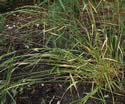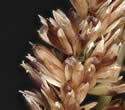Sphenopholis obtusata (Prairie Wedgegrass)
| Also known as: | Prairie Wedgescale |
|---|---|
| Genus: | Sphenopholis |
| Family: | Poaceae (Grass) |
| Life cycle: | annual, short-lived perennial |
| Origin: | native |
| Habitat: | part shade, sun; moist to dry; prairies, meadows, ditches, shores, open forest |
| Fruiting season: | July - August |
| Plant height: | 1 to 4 feet |
| Wetland Indicator Status: | GP: FAC MW: FAC NCNE: FAC |
| MN county distribution (click map to enlarge): |  |
| National distribution (click map to enlarge): |  |
Pick an image for a larger view. See the glossary for icon descriptions.
Detailed Information
Flower: 


![[photo of panicle]](/udata/r9ndp23q/pd3/sphenopholis-obtusata-061817-9-t.jpg) Branching cluster 3 to 8 inches long at the top of the stem, the branches mostly appressed and the panicle usually erect and spike-like, sometimes nodding some to one side. Short-stalked spikelets (flower clusters) are overlapping and crowded on each branch, somewhat flattened, 2 to 5 mm (to ~¼ inch) long, and have 2 or 3 florets.
Branching cluster 3 to 8 inches long at the top of the stem, the branches mostly appressed and the panicle usually erect and spike-like, sometimes nodding some to one side. Short-stalked spikelets (flower clusters) are overlapping and crowded on each branch, somewhat flattened, 2 to 5 mm (to ~¼ inch) long, and have 2 or 3 florets.
![[close-up of spikelet]](/udata/r9ndp23q/pd3/sphenopholis-obtusata-061817-s7-t.jpg) At the base of a spikelet is a pair of bracts (glumes), both shorter than the spikelet, keeled, rough along the keel, awnless, the upper glume 1.5 to 3 mm long, rounded and hood-shaped at the tip, widest near the tip, weakly 3-veined, the lower glume 1-veined, oblong-linear, nearly as long as the upper glume and less than 1/3 as wide. Florets are surrounded by a pair of bracts (lemma and palea), the lemma 1.4 to 4 mm long, weakly 5-veined, blunt to pointed at the tip, awnless; the palea is membranous, somewhat shorter than the lemma. The thickened base of the floret (callus) is hairless; the stalk between florets (rachilla) is hairless.
At the base of a spikelet is a pair of bracts (glumes), both shorter than the spikelet, keeled, rough along the keel, awnless, the upper glume 1.5 to 3 mm long, rounded and hood-shaped at the tip, widest near the tip, weakly 3-veined, the lower glume 1-veined, oblong-linear, nearly as long as the upper glume and less than 1/3 as wide. Florets are surrounded by a pair of bracts (lemma and palea), the lemma 1.4 to 4 mm long, weakly 5-veined, blunt to pointed at the tip, awnless; the palea is membranous, somewhat shorter than the lemma. The thickened base of the floret (callus) is hairless; the stalk between florets (rachilla) is hairless.
Leaves and stems: 

![[photo of sheath, ligule and node]](/udata/r9ndp23q/pd3/sphenopholis-obtusata-061817-s1-t.jpg) Leaves are alternate, 2 to 5½ inches long, 2 to 8 mm (to ~1/3 inch) wide, mostly flat, smooth to slightly rough-textured, hairless to sparsely hairy. Sheaths are hairless to sparsely hairy. The ligule (membrane where the leaf joins the sheath) is 1.5 to 3.5 mm long, jagged across the top, and lacks fringe of hairs. Nodes are hairless. Stems are slender, unbranched, hairless, erect to ascending, and multiple from the base, forming clumps.
Leaves are alternate, 2 to 5½ inches long, 2 to 8 mm (to ~1/3 inch) wide, mostly flat, smooth to slightly rough-textured, hairless to sparsely hairy. Sheaths are hairless to sparsely hairy. The ligule (membrane where the leaf joins the sheath) is 1.5 to 3.5 mm long, jagged across the top, and lacks fringe of hairs. Nodes are hairless. Stems are slender, unbranched, hairless, erect to ascending, and multiple from the base, forming clumps.
Fruit: 
![[photo of mature florets and glumes (side view)]](/udata/r9ndp23q/pd3/sphenopholis-obtusata-070117-s4-t.jpg) Spikelets turn light brown to purplish as they dry and the entire spikelet drops off at maturity leaving the naked stalk behind; sometimes the uppermost floret drops off first. Grains (seeds) are elliptic, amber-colored to brown.
Spikelets turn light brown to purplish as they dry and the entire spikelet drops off at maturity leaving the naked stalk behind; sometimes the uppermost floret drops off first. Grains (seeds) are elliptic, amber-colored to brown.
Notes:
Sphenopholis species are cool-season grasses, usually clump-forming, with erect to nodding panicles, spikelets 2 or 3-flowered, unequal glumes both shorter than the spikelet, the lower glume much narrower than the upper, and the entire spikelet dropping off at maturity, sometimes the upper floret dropping off first. The panicle may be open and lemmas are sometimes awned but the two species in Minnesota have mostly erect panicle branches, so can appear more spike-like (though may be nodding), and glumes and lemmas all lack awns.
Slender Wedgegrass (Sphenopholis intermedia) is distinguished from Prairie Wedgegrass (Sphenopholis obtusata) by its upper glume being blunt to pointed at the tip where the latter is more distinctly hood-shaped. Both are usually hairless, sometimes short-hairy, and spikelets are usually less than 4 mm long. Prairie Wedgegrass is more likely to have an erect, spike-like panicle and be found in open prairie-like habitats where Slender Wedgegrass often has a nodding panicle and is more shade-tolerant, found in a wider variety of habitats including bogs, swamps, floodplains, river gorges, bluffs, open woods and wooded slopes. At one time these two were considered vars of the same species, S. obtusata var. major (intermedia) and var. obtusata.
Native Plant Nurseries, Restoration and Landscaping Services ↓
More photos
Photos by Peter M. Dziuk taken in his garden.
Comments
Have you seen this plant in Minnesota, or have any other comments about it?







 Prairie Wedgegrass plant
Prairie Wedgegrass plant mature branches
mature branches